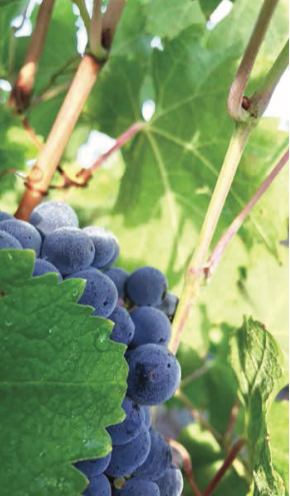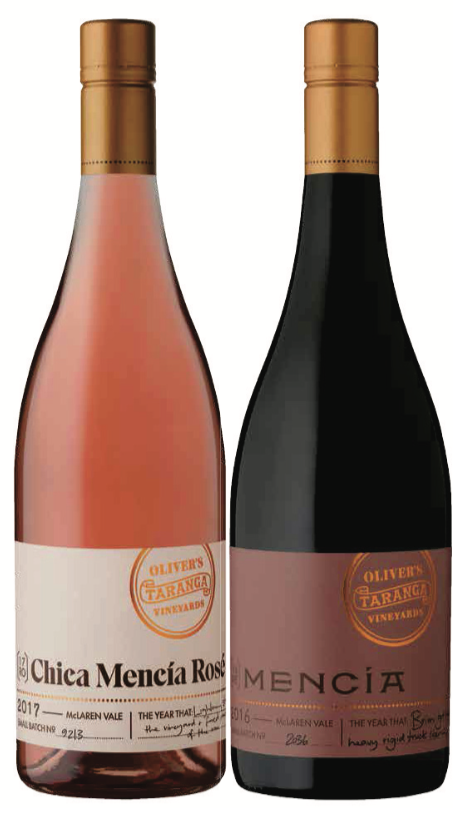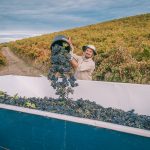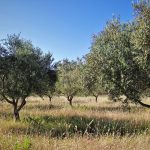By Corrina Wright, Director and Winemaker, Oliver’s Taranga, McLaren Vale, South Australia
First published in the March/April 2018 issue of the Wine & Viticulture Journal


Sometime in 2010 I had an interesting phone call from Nick Dry, Yalumba Nursery manager. It went something along the lines of, “I hear that you have an interest in Mencia? Well, we just have had some come out of quarantine and don’t have anywhere to plant them out. Would you be interested?”
Truth was, I did indeed have an interest in Mencia. I had tasted a number of very impressive wines from makers such as Descendientes de J Palacios, from the region of Bierzo, in north western Spain. It interested me as a possible red wine option for our McLaren Vale vineyard that would be somewhere between Shiraz and Pinot in weight, with a more floral lift. Also, conveniently, we had a small 1.2ha parcel of bare land on the Taranga vineyard that we were looking for something ‘different’ to plant. The soils on this block consist of a shallow red-brown loam over ironstone and limestone which have a typically low water-holding capacity and low vigour.
Research into Mencia in Australia was pretty much non-existent at the time. One thing we did know from Spain was that the higher quality Mencia was from older vines grown at altitude on schist soils. We didn’t have any altitude to speak of, but our soil is mineral heavy, albeit with ironstone instead of schist. So, we decided to give it a crack and take ourselves on a big learning curve.
The first issue was the fact that there was not much budwood to begin with, so the vines had to be planted out at 2m x 3.3m spacings on the block, which was done over three years from 2011 to 2013. This meant that the vineyard was pretty unbalanced, with some vines being in production, while others were still juvenile. This posed some challenges with irrigation of the block. It had to be irrigated as one block, but really needed to be three separate small blocks to be ideal.
The vines grew with medium vigour. They have typically short node lengths and didn’t exactly jump out of their socks vegetatively. However, crop load is a different matter. We have noticed that each bud tends to have multiple shoots from it, usually three or four, and each one fruits quite strongly with two large bunches at least. The shoot length is not excessive, however, and this results in significant clumping of fruit. We now do careful shoot thinning post-budburst to bring the shoots back to one per bud. We have been spur pruning and will continue to do so.
The bunches of Mencia are relatively large and very tightly packed. Berries are medium-large, somewhat similar to Tempranillo, with very thick skins. The flavour is very different from any other variety I have tasted. It is so floral and lifted that it almost tastes like it is a non-Vinifera variety. I relate it to watermelon just as it is starting to go off, mixed in with loads of floral, red berry and blackberry characters as well. While the skins are very thick, the berries have a thinner, juicier element than other varieties, being less pulpy in the mouth.
Mencia veraison is similar in timing to Tempranillo, which is usually the earliest red variety to turn on our vineyard, sometimes as early as late December. It is usually harvested relatively early as well, mid to late February being typical. In terms of disease susceptibility we haven’t seen any particular issue in our vineyard. While bunches are very tightly packed, the skin of the berries is quite thick, plus our region doesn’t generally have a very high botrytis pressure. Some of the information out of Spain does suggest that it can be more susceptible to botrytis in higher pressure seasons or regions.
Mencia doesn’t seem to be a particularly water hungry variety. Our experience on our very low vigour, low water-holding block shows it needs a little bit more than Shiraz, but less than Tempranillo. Maybe this is due to the fact that Mencia doesn’t have a huge canopy to support.
In terms of winemaking, we have been making a dry rose from Mencia since 2014. Wanting to capitalise on the wonderful floral aromas, I have been using carbonic maceration for two to three days, then pressing off and fermenting as a white. Mencia does tend to lose acidity as it ripens (again, like Tempranillo), but picking at around 11.5 Baume for rose, this isn’t an issue. Our rose has a lovely savoury character together with a watermelon rind note that seems to be typical year in and year out. The rose has been a very popular addition to our range, possibly due to the fact that the demand for dry rose has skyrocketed over the last few years and consumers are not fussed by what variety the rose is made from as long as it is delicious.
So far I have only made a couple of small batch red wines from the Mencia. It has huge potential, but trying to get the balance right in the vineyard has taken priority. In 2016, we made a ‘joven’ style, which was delicious, slurpy and had all the vibrant florals. I am looking to continue that style in 2018, which is currently bubbling away on skins. I have only used older French oak hogsheads for ageing, looking to preserve the lovely aromatics of the variety in the wine, rather than have any oak flavour as such. While made in tiny quantities, this wine received a lot of really positive feedback, and sold very strongly at the cellar door.
Overall, I am very glad that Nick made the phone call. While it is early days, I think it is a variety that will continue to add interest to our offering and I look forward to learning more about how to get the best from the variety as the vines age and come out of their adolescence. I am also looking forward to one day travelling to Spain to see first-hand the vines of Bierzo and surrounding regions for myself.
MENCIA

By Peter Dry, Emeritus Fellow, The Australian Wine Research Institute
BACKGROUND
Mencia (men-SEE-ah*) probably originated in Bierzo, Spain, in the province of Leon in the northern inland region of Castile (Castilla y Leon) where it is now mainly grown. It is also found in two other zones in the Galicia region, Ribera Sacra and Valdeorras. The global area in 2010 was 10,658ha: 77% in Spain and 22% in Portugal. It makes up almost 40% of the total planted area of both Leon and Asturias. Synonyms include Jaen, Loureiro Tinto and Mencia Pajaral. It has been shown by DNA profiling that Mencia is identical to the Jaen da Dao from Portugal, but the Jaen that is grown in southern Spain is a completely different variety. In Australia, there are at least four wine producers (in SA and Victoria) and 4ha planted in SA (McLaren Vale, Barossa Valley, Adelaide Hills).
VITICULTURE
Budburst is early to mid-season and maturity is midseason. Vigour is moderate with an erect growth habit. Bunches are medium and well-filled-to-compact with medium berries. Yield is moderate. Spur pruning is used in Australia. Bunches are susceptible to bunch rot. Berry acidity is only moderate. Two clones are available in Australia.
WINE
In the Castile region, Mencia is regarded as a variety with good potential and diverse possibilities for winemaking, either for carbonic maceration wines or for those capable of ageing. It is also used in blends. Although not deeply coloured, it has good potential for high quality wines. Lighter styles of Mencia wine are fresh with intense fruit characteristics of blueberry, strawberries and raspberries, with some savoury notes. Medium to heavier bodied wine styles can vary from tannic oaky wines to softer, smooth styles, with strong berry fruit and herbal, savoury, gamey flavours.
*If you are in the habit of pronouncing place names in Spain in the Castilian manner; for example, Barcelona as barth-eh-lona, then you may prefer to pronounce this variety as men-THEE-ah.















